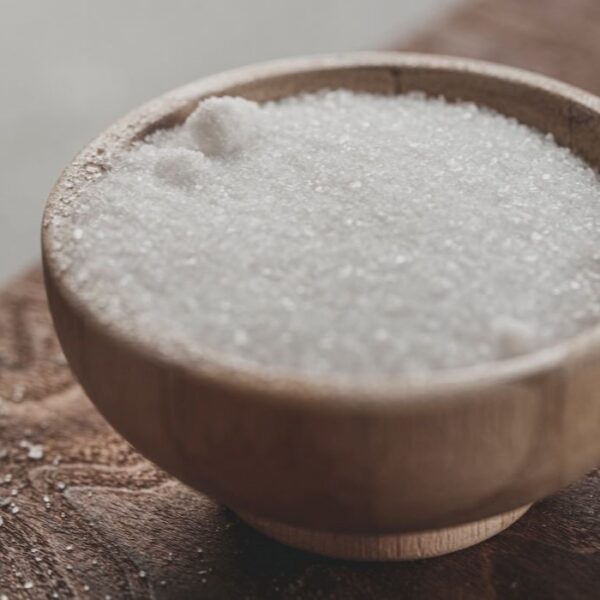Disodium EDTA, or edetate disodium, is an odorless crystalline powder commonly used as a food additive. It is a preservative, chelating, flavoring, color retention aid, curing agent, and antioxidant synergist.
What is Disodium EDTA?
Disodium EDTA (ethylenediaminetetraacetic acid) is the disodium salt form of edetate. It is a chelating agent used to sequester metal ions in aqueous solutions. The chemical formula of disodium EDTA is C10H14N2Na2O8 · 2H2O.
Chemical Structure of Disodium EDTA
Source: Wikidata
How is Disodium EDTA Produced?
Industrially, disodium EDTA is synthesized from ethylenediamine (1,2-diaminoethane), formaldehyde, and sodium cyanide. This synthesis yields tetrasodium EDTA, which is then converted into other forms. Disodium EDTA is a synthetic molecule and is not found naturally.
Applications in the Food Industry
Disodium EDTA serves a variety of purposes that makes it valuable in food product formulations:
- Inhibits rancidity in fat-rich food products, playing an important role in extending shelf life.
- By chelating/sequestering cations/metal ions, Disodium EDTA prevents oxidation.
- Binds to metals and prevents them from participating in chemical reactions that might cause discoloration or flavor loss.
- Acts as an antioxidant synergist by chelating the heavy metal ions accountable for the oxidation of chemical species, extending the shelf life of oxidation-labile food products.
Product Examples
| Type | Examples |
| Dressings, Sauces, and Spreads | Salad dressings, Hot sauce, Mayonnaise |
| Pickled Vegetables | Cucumbers, Cabbage |
| Canned Beans & Legumes | Kidney beans, Black beans, Lentils |
| Canned Carbonated Soft Drinks | Canned soda |
| Canned Seafood | Crab, Clam, Shrimp |
Properties of Disodium EDTA
| Physical Form | Powder/crystalline granules |
| Color | White |
| Odor | Odorless |
| Shelf Life | >60 months |
| Storage Temperature & Conditions | 2-8 °C |
| Appearance | White crystalline powder |
| pH (1 % Aqueous) | 4.3 – 4.7 |
| Density @ 25 °C | 1.01 g/cm3 |
| Molar Mass | 372.24 g/mol |
| Melting Point | 242 °C |
| pKa values | 2.0, 2.7, 6.2, 10.3 |
| Vapor pressure | 7.57X10-17 mm Hg at 25°C |
| Refractive Index | n20/D 1.363 |
| Solubility | Freely soluble in water, practically insoluble in ethanol |
| Claims (*Product Specific) | Kosher*, Halal* |
Recommended Storage and Handling
Store in tightly closed containers away from direct sunlight. Store away from incompatible substances in a cool, dry, and well-ventilated area.
Typical Disodium EDTA Formulations
Mayonnaise
Here is an example of a mayonnaise formulation table with disodium EDTA, along with the % weight of ingredients:
| Ingredients | % Composition |
| Sunflower oil | 60 |
| Acetic acid | 4 |
| Egg powder | 5 |
| Sugar | 1 |
| Salt | 1 |
| Mustard powder | 0.3 |
| Disodium EDTA | 0.15 |
| Sodium benzonate | 0.03 |
| Citric acid | 0.03 |
| Corn starch | 5 |
| Water | 23.49 |
Source: IOP
Pickled Cucumber
Here is an example of a pickled cucumber formulation table with disodium EDTA along with the % weight of ingredients:
| Ingredients | % Composition |
| Cucumber | 8.5 kg |
| Sodium chloride | 5 |
| Calcium chloride | 0.35 |
| Acetic acid | 0.1 |
| Potassium sorbate | 0.05 |
| Calcium disodium EDTA | 50-200 ppm |
Source: Wiley
Disodium EDTA Formulation Considerations
| Physical Forms | Powder & crystals |
| Stability | Heat: Decomposes at 252°CLight: LabileOxidation: Stable |
| Sensory Attributes | Odorless, Slightly salty flavor |
| Dosage | 50-500 ppm (Varies as per application) |
| Acceptable Daily Intake (ADI) | 2.5 mg/kg bw |
| Interaction with Other Components | Incompatibility: Strong oxidizers, iron, brass, copper, and strong alkali |
| Effects on Functional Properties of Food | In one study, adding EDTA improved both foam overrun and foam stability of low- and high-heat milk. The increase in serum protein resulting from the addition of EDTA contributed to the improvement in the foaming properties of milk by increasing the availability of the proteins for the formation of the air-water interface. A study of EDTA showed positive effects on Pacific white shrimp’s physical and sensory properties during ice storage in terms of drip loss and shear force. It also increased the shelf life from 5 days to 7 days.EDTA has been shown to help prevent the undesirable darkening of banana slices during dehydration. EDTA helped preserve color, texture, and sensory properties in pickled cucumbers. |
Safety & Regulatory Considerations
| FDA Information | The FDA has approved calcium disodium EDTA as a safe food additive but has set limitations on the amount of the substance a food can contain. |
| EU Information | The EU has approved EDTA as an additive in food products with maximum permissible limits in designated categories. |
| Canada Regulatory Information | Canada has approved EDTA as a sequestering agent in specified food categories. |
Health Effects of Disodium EDTA
- Anti-Hypercalcemic — Disodium EDTA chelates calcium ions and thus can help in hypercalcemia. It is clinically indicated in selected patients for the emergency treatment of hypercalcemia. Calcium disodium EDTA is indicated via chelation therapy for lead poisoning and leads to encephalopathy in pediatric and adult populations.
- Anti-Arrhythmic — Chelation therapy with disodium EDTA has been used for many years for atherosclerosis. It shows antiarrhythmic properties.
Safety & Toxicity of Disodium EDTA
- Because disodium EDTA is a chelating agent, it can be cytotoxic and weakly genotoxic when consumed at high concentrations. However, it is not reported to be carcinogenic.
- Oral exposures to EDTA produced adverse reproductive and developmental effects in animals. The lowest dose reported to cause a toxic effect in animals was 750 mg/kg/day. However, the ADI for disodium EDTA has been set to 2.5 mg/kg. Serious concerns have been expressed over the excessive use of EDTA in cosmetic formulations due to the likelihood of indirect ingestion through inhalation.
- EDTA is one of the most common organic pollutants with poor biodegradability. EDTA is a persistent substance in the environment and contributes to heavy metals’ bioavailability and remobilization processes. Its effects on the environment are a significant concern.
Identification Numbers
| Chemical Name | Disodium salt of N,N’-1,2-Ethanediylbis[N-(carboxymethyl)glycine];disodium dihydrogen ethylenediaminetetraacetate; disodium dihydrogen(ethylene-dinitrilo)-tetraacetate |
| CAS Number | 139-33-3 |
| REACH Registration Status | Registered under the REACH Regulation |
| EC Number | 205-358-3 |
| ELINCS Number | 205-358-3 |
| INS No. (Food Additive) | 386 |
| FEMA Number | 4520 |
Acceptable Limits or Maximum Usage
Per the FDA, the maximum usage levels of disodium EDTA in food products are as follows:
| Food | Limitation (parts per million) |
| Aqueous multivitamin preparations | 150 |
| Canned black-eyed peas | 145 |
| Canned kidney beans | 165 |
| Canned strawberry pie filling | 500 |
| Cooked sausage | 36 |
| Dressings, non-standardized | 75 |
| French dressing | 75 |
| Frozen white potatoes including cut potatoes | 100 |
| Gefilte fish balls or patties in packing medium | 50 |
| Legumes (all cooked canned, other than black-eyed peas) | 165 |
| Mayonnaise | 75 |
| Ready-to-eat cereal products containing dried bananas | 315 |
| Salad dressing | 75 |
| Sandwich spread | 100 |
| Sauces | 75 |
Source: FDA
Additional Resources
- Synthesis of EDTA
- Legislation.gov.uk – Annex Division 154
- Approved Additives and E-numbers – Food Standards Agency
- EUR-Lex – Regulation (EC) No 1333/2008
- International Programme on Chemical Safety – Disodium EDTA
- Journal of Food Science – EDTA: A Versatile Food Additive
- ScienceDirect – EDTA Disodium Salt
- ChemBK – Disodium EDTA
- Material Safety Data Sheet (MSDS) – Disodium EDTA
- IRO Chelating – Foods That Contain EDTA
- ResearchGate – Food Preservation with EDTA
- International Programme on Chemical Safety – EDTA
- Journal of Food Science – Use of EDTA in Canned Vegetables






